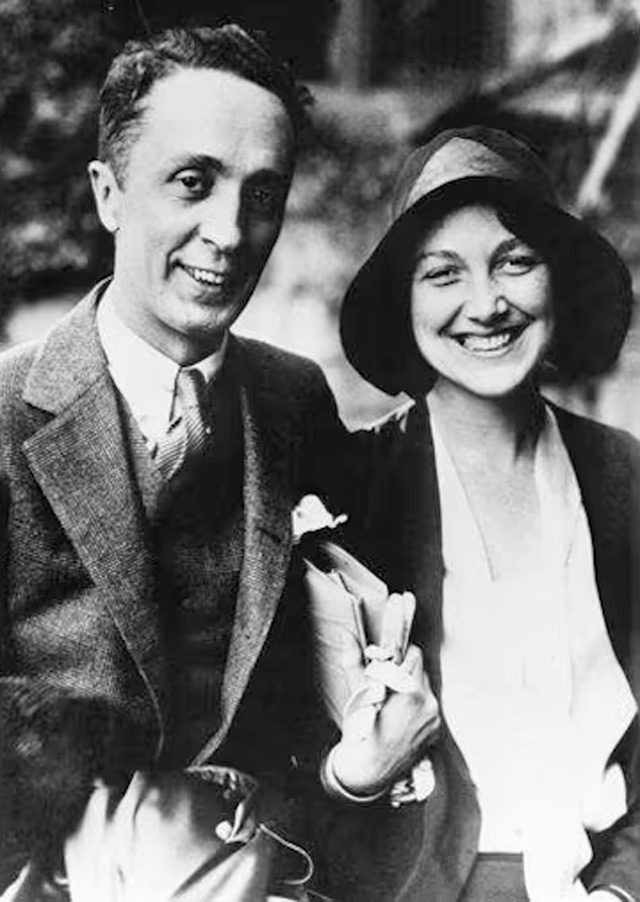
When you think of Norman Rockwell, vivid images of Americana likely spring to mind: the small-town charm, the everyday heroes, the quintessential moments of mid-20th century American life. Yet, behind these iconic illustrations, there’s a love story often overlooked — the story of Norman Rockwell and his supportive wife, Mary Barstow. Their partnership was a cornerstone of Rockwell’s prolific career, providing emotional and practical support that helped him become one of the most beloved artists in American history.
A Love Story Begins
Norman Rockwell met Mary Barstow in 1930, and it was love at first sight. They were introduced at a dance in California, where Mary was teaching school. Norman, born on February 3, 1894, in New York City, was 36 years old at the time, while Mary, born on May 26, 1907, in Stockbridge, Massachusetts, was 23. Their age difference did nothing to diminish the immediate connection between them. Norman, instantly smitten, saw in Mary not just a beautiful and intelligent woman but also a steadfast partner who would later become his rock in both personal and professional spheres.
Their courtship was swift, a whirlwind of letters and visits, and they were married on March 17, 1930. The union marked the beginning of a dynamic duo that would navigate the ups and downs of a life devoted to art and family. Norman’s career was already taking off, but Mary’s influence would become an essential part of his journey, offering him the stability and encouragement he needed.
Mary was no ordinary housewife. She was well-educated, having attended Vassar College, where she graduated in 1923. Her academic background and cultural sophistication brought a sense of intellectual rigor to their relationship. Her presence allowed Norman to feel secure and inspired, knowing that he had someone who not only understood his work but also appreciated the broader cultural context in which it existed.
Building a Life Together
The Rockwells settled in New Rochelle, New York, a vibrant artist colony. This move was strategic, allowing Norman to be close to other illustrators and the headquarters of major magazines. Here, they built a home and started a family, with Mary taking on the role of caregiver while Norman focused on his art.
Their family life began to flourish in the 1930s. The couple welcomed their first child, Jarvis Waring Rockwell, on October 18, 1932. Thomas Rhodes Rockwell, their second son, was born on March 13, 1933. Finally, Peter Barstow Rockwell, their youngest, was born on September 2, 1936. Mary’s role extended far beyond that of a traditional homemaker. She managed the household, raising their three sons, and ensured that Norman had the peace and space he needed to work. Her understanding of the demands of his career was crucial; she shielded him from distractions and took care of the logistics of daily life, allowing him to immerse himself in his creative process.
Their home was a lively place filled with the laughter of children and the bustle of domestic life. Yet, it was also a sanctuary where Norman could retreat and recharge. Mary’s ability to create this balance was a testament to her strength and dedication. She understood the pressures of Norman’s work and made sure that their home was a place where he could both find inspiration and solace.
Norman often spoke about how important Mary was to his work. He once said, “Without Mary, I would not have been able to paint at all. She made our home a place where creativity could thrive.” This quote encapsulates the essence of their relationship: a partnership where each person’s contributions were vital to the other’s success.
The Challenges of Fame
As Norman’s fame grew, so did the pressures and challenges that came with it. The Rockwell family found themselves in the public eye, with Norman’s work appearing on the covers of The Saturday Evening Post and other major publications. His first Post cover, “Boy with Baby Carriage,” had been published on May 20, 1916, setting him on a path to becoming one of America’s most recognizable illustrators. This visibility brought both opportunities and difficulties.
Mary was instrumental in helping Norman navigate the complexities of fame. She provided a buffer between him and the outside world, managing the media and public appearances so that he could focus on his art. Her organizational skills and calm demeanor were invaluable during these times of heightened attention.
Fame also meant that their personal life was often under scrutiny. Mary’s ability to maintain a sense of normalcy for their children amidst the chaos was remarkable. She made sure that their boys had a stable and loving environment, even as their father’s career soared to new heights. Her efforts ensured that the family remained grounded despite the whirlwind of publicity.
However, fame also brought personal challenges. Norman’s intense work schedule and the pressures of public life took a toll on their relationship. There were moments of strain and difficulty, but Mary’s unwavering support and resilience helped them weather these storms. She was the constant in Norman’s life, providing the strength and stability that allowed him to continue creating his iconic art.
The Role of Mary in Rockwell’s Art
Mary’s influence on Norman’s work was profound. While she rarely appeared as a direct subject in his paintings, her presence was felt in the themes and emotions he portrayed. The warmth, humor, and humanity that characterize Rockwell’s art were reflections of the love and stability he found in his marriage.
Mary’s intellectual and cultural background enriched Norman’s perspective. She introduced him to literature, music, and art that broadened his horizons and influenced his creative vision. Their home was filled with books, music, and lively discussions that fed Norman’s imagination and inspired his work.
One of the most significant ways Mary impacted Norman’s art was through her role as a critic and sounding board. She was often the first person to see his sketches and hear his ideas. Her feedback was invaluable, providing both encouragement and constructive criticism. Norman trusted Mary’s judgment and valued her opinion, knowing that she had his best interests at heart.
In many ways, Mary’s influence can be seen in the emotional depth and complexity of Rockwell’s work. Her support allowed him to explore a wide range of subjects and emotions, from the joy and innocence of childhood to the profound and sometimes challenging themes of the human experience. Her presence gave him the confidence to push boundaries and delve deeper into his art.
Coping with Personal Struggles
Life was not always easy for the Rockwells. They faced numerous personal challenges, including Mary’s struggle with alcoholism. This was a difficult period for the family, and it tested the strength of their relationship. Norman, deeply affected by Mary’s illness, sought to support her while also maintaining his demanding career.
Mary’s battle with alcoholism was a painful and private struggle. It affected her health and well-being, and the stress of coping with her illness weighed heavily on Norman. However, he remained devoted to her, determined to help her through this difficult time. Their love and commitment to each other were evident as they faced this challenge together.
Despite the difficulties, Mary’s strength and resilience shone through. She sought treatment and worked hard to overcome her addiction, demonstrating remarkable courage and determination. Norman’s unwavering support played a crucial role in her recovery, and their bond grew even stronger as they navigated this challenging period.
The experience of dealing with Mary’s alcoholism had a profound impact on Norman’s work. It added a layer of emotional depth and sensitivity to his art, reflecting the personal struggles and triumphs he experienced. This period of their lives was a testament to the power of love and support in overcoming adversity.
Legacy and Impact
Mary Barstow Rockwell passed away on August 25, 1959, leaving behind a legacy deeply intertwined with Norman’s. Norman continued to work for many years after her death, creating some of his most impactful works during the 1960s. Her support, intelligence, and strength enabled Norman to achieve his artistic vision and leave a lasting mark on American culture.
The Rockwell marriage exemplifies the importance of partnership and mutual support in achieving great things. Mary’s role as a supportive wife and mother allowed Norman to focus on his art, while her intellectual and cultural influence enriched his work. Their relationship was a true collaboration, with each person’s contributions enhancing the other’s success.
Mary’s impact on Norman’s work is evident in the themes and emotions he explored. Her presence in his life provided the stability and inspiration he needed to create art that resonated with people on a deeply emotional level. The love and support they shared are reflected in the warmth and humanity that characterize Rockwell’s illustrations.
In many ways, Mary Barstow Rockwell was the unsung hero behind Norman’s success. Her unwavering support and dedication were the foundation upon which he built his career. The Rockwell family’s story is a testament to the power of love and partnership in achieving greatness, and Mary’s legacy lives on in the timeless art that continues to inspire and delight people around the world.




